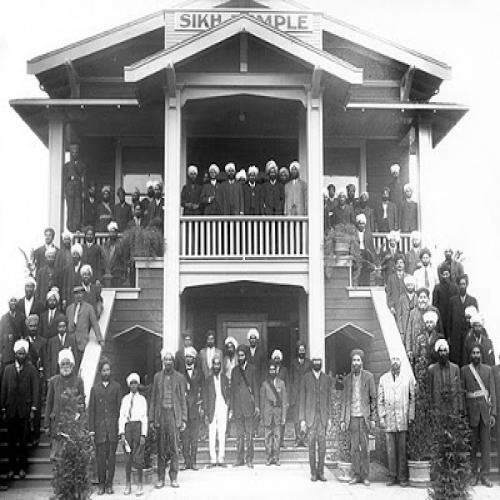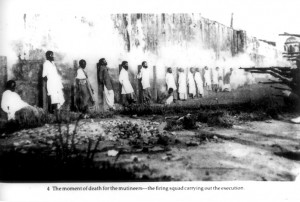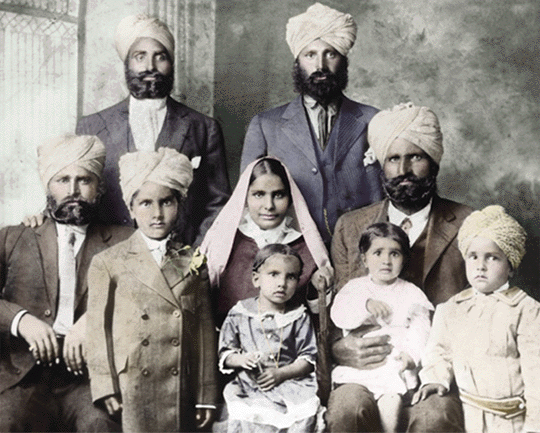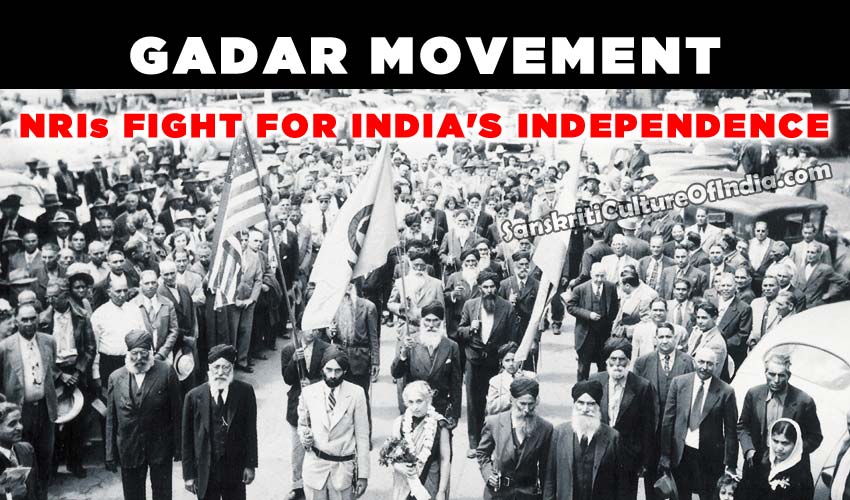India’s independence has long been attributed to Mohandas Gandhi, Congress leaders and their struggle for freedom. In the midst of their limelight, the world has forgotten many other unsung heroes who lost their lives in hopes to see India free from the clutches of British Raj. There is not a single peep about them in history books or their movements that helped create a whirlwind of nationalistic pride in the shattered people of India. This is one such story that needs to be put back in the pages of antiquity.
Gadar Movement is the saga of courage, valor and determination of overseas Indians who had come to Canada and the United States either for higher education or for economic opportunities. They imbibed the fire and zeal of revolutionaries and became the trail blazers of freedom struggle for their motherland, India. They may have lived ordinary lives but they left an extra-ordinary legacy.
 At the dawn of the twentieth century, both India and Canada were British dominions, so, Indians had easier access to emigrate to Canada. The new immigrants were hard working and accepted lower wages, so some Canadian companies publicized the economic and job opportunities available in Canada to seek more cheap labor from India. During the first few years, every year about 2000 immigrants, mostly Punjabi farmers and laborers were permitted to come. As the number of immigrants increased, the locals felt threatened by labor competition from the hardy and adventurous Punjabis. Fear of labor competition led to racial antagonism and demands for exclusionary laws from cheap foreign Asian workers. In 1909, severe immigration restrictions virtually ended legal Indian immigration to Canada.
At the dawn of the twentieth century, both India and Canada were British dominions, so, Indians had easier access to emigrate to Canada. The new immigrants were hard working and accepted lower wages, so some Canadian companies publicized the economic and job opportunities available in Canada to seek more cheap labor from India. During the first few years, every year about 2000 immigrants, mostly Punjabi farmers and laborers were permitted to come. As the number of immigrants increased, the locals felt threatened by labor competition from the hardy and adventurous Punjabis. Fear of labor competition led to racial antagonism and demands for exclusionary laws from cheap foreign Asian workers. In 1909, severe immigration restrictions virtually ended legal Indian immigration to Canada.
When Indian immigrants saw the doors closing on them in Canada, they started coming to the United States which needed more people to do hard labor work to build new communities. In the U.S, they faced many difficulties, suffered numerous hardships and encountered rampant discrimination. Initially, they could find only menial jobs, but over a period of time and with their hard work and determination, many of them became successful farmers with their own land.
Within a span of few years, number of immigrant workers had swelled, so they starting facing widespread hostility which led to racial riots, resulting in certain cases, a loss of life and property. Like Canada, the United States, which had initially welcomed the Asian labor to do menial jobs, enacted Asian exclusionary laws to bar Asians emigrating to the United States.
For discriminatory treatment and damages in race riots, the Japanese and Chinese governments sympathized with their overseas nationals and negotiated with the American government for compensation for life and property losses. But the British Indian Government would not make any representation to the U.S. Government for similar losses. Indians soon realized the difference between the citizens of a “slave” country and those ruled by their own people.
The United States had also welcomed qualified Indian students seeking admissions in the American universities. However, upon graduation, they were not able to get jobs commensurate with their qualifications. The discriminatory practices were against the very ideals of liberty and freedom they had seen in their University environment. The Indian students attributed the racial prejudice and discrimination to their being nationals of a subjugated country. They were motivated to get rid of the foreign rule in India and were determined to fight for freedom for their motherland. They also started fostering feelings of patriotism and nationalism among their fellow Indian Immigrants.
Many Indians and particularly Indian students in the USA, Canada, England, Germany, and France, started advocating freedom for their motherland, India from British serfdom. They formed organizations or groups for India’s freedom. Taraknath Das, a student, started publishing a magazine Free Hindustan in 1907 in Seattle, advocating armed rebellion against the British rule in India and also formed “East India Association” in 1911; G. D. Kumar started a Punjabi paper Swadesh Sewak in Vancouver while Shymji Krishna Varma founded Indian Home Rule Society in London.
 In the United States, Har Dyal who had come from England after relinquishing his scholarship and studies at Oxford University was identified with nationalist activities. He inspired many students studying at the University of California at Berkeley. Two of his many student followers, Katar Singh Sarabha and Vishnu Govind Pingle later on played very prominent role in the Gadar movement. Dyal’s fervor for India’s freedom spread beyond the university campuses. A meeting of some patriotic and enlightened Indians was called on April 23, 1913, in Astoria, Oregon, where Har Dyal, Bhai Parmanand and others passionately spoke for throwing the British out of India. It was at this meeting that Hindustan Association of the Pacific Coast was formed with a major objective to liberate India with the force of arms from British colonialism, just as Americans had done more than a century ago, and help establish a free and independent India with equal rights for all. Sohan Singh Bhakna was elected President, Hardayal, General Secretary, and Pandit Kanshi Ram Mardauli, Treasurer. Lala Har Dayal who had been a faculty member at Stanford University for about two years, was the central figure and the force behind the newly formed organization.
In the United States, Har Dyal who had come from England after relinquishing his scholarship and studies at Oxford University was identified with nationalist activities. He inspired many students studying at the University of California at Berkeley. Two of his many student followers, Katar Singh Sarabha and Vishnu Govind Pingle later on played very prominent role in the Gadar movement. Dyal’s fervor for India’s freedom spread beyond the university campuses. A meeting of some patriotic and enlightened Indians was called on April 23, 1913, in Astoria, Oregon, where Har Dyal, Bhai Parmanand and others passionately spoke for throwing the British out of India. It was at this meeting that Hindustan Association of the Pacific Coast was formed with a major objective to liberate India with the force of arms from British colonialism, just as Americans had done more than a century ago, and help establish a free and independent India with equal rights for all. Sohan Singh Bhakna was elected President, Hardayal, General Secretary, and Pandit Kanshi Ram Mardauli, Treasurer. Lala Har Dayal who had been a faculty member at Stanford University for about two years, was the central figure and the force behind the newly formed organization.
The headquarters of Hindustan Association of the Pacific Coast was established in San Francisco, which served as a base for coordination of all the activities of the association. A building was purchased with funds raised from the community, primarily Punjabi farmers and farm and lumber mill workers and was named Yugantar Ashram. The association began publishing a magazine, Gadar, for free distribution to promote the aims, objectives and activities of the organization. Gadar, literally means revolt or mutiny, was published in Urdu, Hindi, Punjabi, among other languages. “The first issue of the journal Gadar was in Urdu and was published on November 1, 1913. An edition of the journal was brought out next month in Gurmukhi and in May 1914 a Gujrati edition of the journal was also published.” Says Anil Ganguly in his book “Ghadar Revolution in America.”The Gadar publication exposed the British imperialism and called upon the Indian people to unite and rise up against British rule and throw the British out of India.
It carried articles on the conditions of the people of India under British Rule and also on problems of racial attacks and discrimination against Indians in the USA and Canada. The publication Gadar, over a period of time, became well known among Indians and the Hindustan Association of the Pacific Coast itself became known as the Gadar party. Besides Gadar, the group brought out various publications to raise the consciousness of the Indian people to revolt against the British. Special issues of Gadar were also printed in Nepali, Bengali, Pashto, Gujrati, as well as in many other languages.
Gadar literature was sent to Indian revolutionaries in India, Europe, Canada, Singapore, The Philippines, Hong Kong, China, Malysia, Singapore, Burma, Egypt, Turkey, and Afghanistan. In a short period of time, publications from the Yugantar Asram, particularly the Gadar magazine became very popular. The British government got alarmed and used every means to stop the circulation of Gadar and other such publications, particularly in India. The magazine, being the principal patriotic literature, reached many people; even if one copy reached India or to a fellow revolutionary elsewhere, multiple copies were made for circulation.
Hindustan Association was barely a few months old when under pressure from the British Indian Government, Har Dyal was arrested by the U.S. Government. He was released on bail on March 24, 1914 but soon left for Switzerland and then to Germany. The sudden departure of Har Dyal did create some vacuum in the organizational structure of the association but it did not cause the death of the organization. The seed of revolt that Har Dyal sowed, had developed into a formidable organization. Many committed and dynamic volunteers continued to work tirelessly and pursued the planned activities of the association.
In Germany, Har Dyal continued to promote his mission, independence for India. He knew that Germans had great sympathy with the Gadar movement because they and Gadarites had common enemy, the British. Har Dyal, along with Virendra Nath Chattopadhyay, younger brother of politician-poetess Sarojani Naidu, Barkatullah, Bhupendra Nath Datta, brother of Swami Vivekananda, Ajit Singh, Champak Raman Pillai, Tarak Nath Das, and Bhai Bhagwan Singh formed Berlin Indian Committee in September 1914, also known as the Indian Revolutionary Society. The objectives of the society were to arrange financial assistance from German Government for revolutionary activities and propaganda work in different countries of the world, plan training of volunteer force of Indian fighters and arrange transportation of arms and ammunitions to reach the Gadarites for a revolt against the British Government in India.
 The war between Germany and England broke out in August, 1914 and created a golden opportunity for gadarites to expel the English from India while British troops would be busy fighting war at the front. The gadarites started forceful campaign to mobilize overseas Indians in Singapore, Burma, Egypt, Turkeyand Afghanistan and particularly Punjabis in Canada and the USA to go to India and launch revolution. They drew plans to infiltrate the Indian army and excite the soldiers to fight not for but against the British Empire and free India from the shackles of British imperialism. The Indian Revolutionary Society in Berlinhad arranged for substantial financial aid from Germany. The German Embassy in Washington had engaged a German National in the United States to liaison with the Gadar leadership in San Francisco . Several ships were commissioned or chartered to carry arms and ammunitions and batches of Indian revolutionaries, about 6000, to India.
The war between Germany and England broke out in August, 1914 and created a golden opportunity for gadarites to expel the English from India while British troops would be busy fighting war at the front. The gadarites started forceful campaign to mobilize overseas Indians in Singapore, Burma, Egypt, Turkeyand Afghanistan and particularly Punjabis in Canada and the USA to go to India and launch revolution. They drew plans to infiltrate the Indian army and excite the soldiers to fight not for but against the British Empire and free India from the shackles of British imperialism. The Indian Revolutionary Society in Berlinhad arranged for substantial financial aid from Germany. The German Embassy in Washington had engaged a German National in the United States to liaison with the Gadar leadership in San Francisco . Several ships were commissioned or chartered to carry arms and ammunitions and batches of Indian revolutionaries, about 6000, to India.
Besides Germany, the gadarites also sought help from anti-British governments. In December 1915, they established a Free Hindustan government-in-exile in Kabul, Afghanistan, with Raja Mohinder Pratap as President, Maulavi Barkatullah as Prime Minister and Champakaran Pillai as Foreign Minister. The government-in-exile tried to establish diplomatic relationships with countries opposed to the British in World war l such as Turkey, Germany, Japan, etc. The gadarites also established contact with the Indian troops at Hong Kong, Singapore, and in some other countries and hoped for their participation in the uprising against the British.
The British Government tried to suppress the Gadar Movement and had hired agents to penetrate the Gadar party almost from the beginning. Har Dyal used the columns of Gadar to caution his compatriots against British spies. The traitors of the Gadar movement leaked out the secret plan to the British spies. As a result, the ships carrying arms and ammunitions never reached India. Germany was originally planning to send more ships carrying arms and ammunition to India, lost interest in the venture after seeing the fate of original vessels. Many gadarites and volunteer fighters were taken captives upon reaching India. Some of the active gadarites who escaped arrests, including Kartar Singh Sarabha and Vishnu Govind Pingle, made alliance with Ras Behari Bose and other known revolutionaries in India. They had come to India to overthrow the British rule and wanted to unite and work with all those forces that were working to liberate India. They tried hard to mobilize the people and infiltrate into various units of the armed forces. But the British spies out maneuvered them. They also could not get the support of Mahatma Gandhi and other leaders of India’s Freedom movement, who had already committed full co-operation with the British Indian Government.

Before leaving for India, the Gadarites were given the impression that India was ready for a revolution. So, when the World War l provided a golden opportunity for them to attain their goal, they hurried homeward for revolution. What an irony; while the gadarites had gone to India to fight willingly for the freedom of their motherland, the Indian leadership openly and willingly co-operated with the British prolonging India’s serfdom; while the overseas Indians prayed in Gurudwaras and temples for the success of Gadarites’ mission, the people in India flocked to Gurudwaras and temples to pray for the victory of the British.
The Gadarites had a flame of liberty lit in their hearts, and did not hesitate to make any sacrifice for the cause of freedom, dignity and prosperity of their motherland. They fought valiantly for their cause; several Gadarites in India were imprisoned, many for life, and some were hanged. In the United States too, many Gadarites and Germans who supported Gadar activities, were prosecuted and some were incarcerated for varying terms of imprisonment. Although the movement did not achieve its stated objective, but it awakened the sleeping India and left a major impact on India’s struggle for freedom. The heroism, courage and sacrifices of the Gadarites inspired many freedom fighters to continue their mission.
A prominent Indian writer, Khushwant Singh, wrote in Illustrated Weekly, on February 26, 1961, “In the early months of World war I, an ambitious attempt to free their country was made by Indians living overseas, particularly in the United States and Canada. Although the overwhelming majority of the Gadrites were Sikhs and the centers of revolutionary activity were the Sikh temples in Canada, the United States, Shanghai, Hong Kong and Singapore, many of the leaders were of other parties and from different parts of India, Har Dayal, Ras Bihari Bose, Barkutullah, Seth Husain Rahim, Tarak Nath Das and Vishnu Ganesh Pingley. …… The Gadar was the first organized violent bid for freedom after the rising of 1857. Many hundreds paid the price with their lives.”
~ Inder Singh











